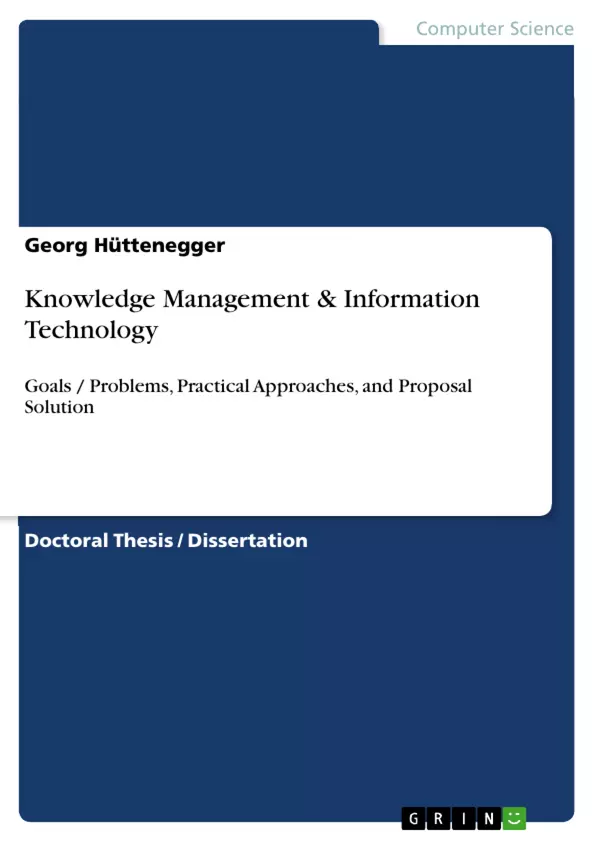This thesis examines the relationship of Knowledge Management (KM) and Information Technology (IT) using a holistic view. The first chapter presents definitions of knowledge and KM, discusses related fields to KM and knowledge types, argues what KM activities can be supported by IT, examines areas of IT related to KM, defines the focus of this thesis, and presents interesting artifacts. As areas that require flexibility, creativity, and learning are especially in need of KM, this thesis concentrates on them. The next chapter analyzes the goals of KM, problems to be addressed by KM-systems, goals and problems of a university, problems of (existing) KM-systems, and the requirements of a KM-system that supports a KM initiative that addresses the mentioned problems and does not suffer from the described problems. Following the identification of requirements for KM-systems, chapter 3 discusses important preconditions and foundations for KM and KM-systems. As a “complete'' KM-system can only be part of a “complete'' and holistic KM initiative, this examination presents indispensable issues for such KM initiatives and discusses the importance and relevance of them. The next chapter presents three existing solutions (CYMANTIX.NET / Oracle / Lotus/IBM). Finally, the chapter examines to what extent the three solutions address the requirements identified and what is missing. The main chapter of this thesis describes the proposed IT solution in the context of a holistic KM initiative. It starts with a discussion of principles such as participatory design, etc. that have to be adhered to when designing, implementing, and introducing the proposed KM-system. Then, the proposed KM-system is presented consisting of three major building blocks, namely the central user interface, the virtual information pool, and automation as well as further aspects. Furthermore, the relationship of eLearning and KM with regard to the proposed KM-system is examined, implementation issues are discussed, and the chapter ends with an evaluation of the proposed solution. The concluding chapter summarizes this thesis and stresses the holistic point of view that is combined with proposing a “complete'' IT system supporting KM. It discusses the pros and cons of this approach evaluation results. Finally, it presents areas that need further research and what the future holds for KM.
Inhaltsverzeichnis (Table of Contents)
- Abstract
- Chapter 1: Definitions and Scope
- Definitions of Knowledge and Knowledge Management
- Related Fields and Knowledge Types
- IT Support for KM Activities
- Focus of the Thesis
- Interesting Artifacts
- Chapter 2: Goals, Problems, and Requirements
- Goals of Knowledge Management
- Problems Addressed by KM Systems
- Goals and Problems of a University
- Problems of Existing KM Systems
- Requirements of a KM System
- Chapter 3: Preconditions and Foundations
- Preconditions for KM in General
- Foundations for KM Systems
- Chapter 4: Existing Solutions
- CYMANTIX.NET
- Oracle Solution
- Lotus/IBM Solution
- Chapter 5: Proposed IT Solution
- Design Principles
- System Architecture
- Central User Interface
- Virtual Information Pool
- Automation
- eLearning and KM
- Implementation Issues
- Evaluation
Zielsetzung und Themenschwerpunkte (Objectives and Key Themes)
This thesis aims to comprehensively examine the relationship between Knowledge Management (KM) and Information Technology (IT), employing a holistic approach. It analyzes the goals of KM, the problems it seeks to address, and the requirements for effective KM systems, particularly within a university setting. The work further investigates existing IT solutions for KM and proposes a new IT solution designed to support a complete and holistic KM initiative. * Defining the relationship between KM and IT * Identifying the goals and problems of KM initiatives * Analyzing existing IT solutions for KM * Proposing a new IT solution for KM * Exploring the role of eLearning in KMZusammenfassung der Kapitel (Chapter Summaries)
Chapter 1 introduces definitions of knowledge and KM, discusses related fields, and establishes the thesis's focus on areas requiring flexibility, creativity, and learning. Chapter 2 analyzes the goals of KM, problems addressed by KM systems, and requirements for a successful KM system. Chapter 3 examines preconditions and foundations for KM initiatives and systems. Chapter 4 presents and evaluates three existing KM solutions (CYMANTIX.NET, Oracle, and Lotus/IBM), assessing their strengths and weaknesses in fulfilling identified requirements. Chapter 5 details the proposed IT solution, including its design principles, architecture, and integration with eLearning.Schlüsselwörter (Keywords)
Knowledge Management (KM), Information Technology (IT), Holistic Approach, KM Systems, Requirements Engineering, eLearning, University, Participatory Design, System Architecture, Solution Evaluation.- Quote paper
- Dr. Georg Hüttenegger (Author), 2004, Knowledge Management & Information Technology, Munich, GRIN Verlag, https://www.grin.com/document/121189



